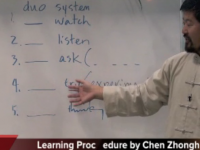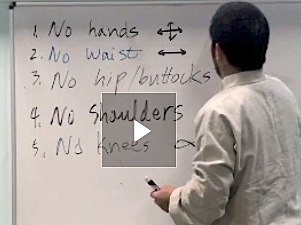1. Look: Use your eyes to observe and remember.
- Do not move your body. Do not copy. If you copy at this stage, your brain will link what you see to what you can copy. This may give a false impression that you’ve understood the movement. This is how bad habits are formed.
- Just focus on whether you’ve seen clearly. You can see it repeatedly. You can change your angle and point of observation.
- Do not analyse. Do not judge the quality of the movement. At this stage, right or wrong, it doesn’t matter.
2. Listen: Use your ears to hear and remember.
- Just focus on whether you’ve heard it clearly. If it isn’t clear, request the teacher to repeat.
- Do not judge what you hear. Whether you agree with the teacher or not, it doesn’t matter at this stage.
- Do not listen and perform at the same time.
- If there are new words or concepts, just make a mental note of it.
3. Ask: Request your teacher to repeat
- Do not ask why. The answer to “why questions” are too complex at this stage. It will affect your progress in learning.
4. Practise: Use your body to copy what you’ve seen and heard.
- This is the key. Your ability to see and listen is a gift from “God”, it is not inferior to anybody else, so you do not need to doubt your ability in these 2 areas. But your ability to copy depends on your life experience. Everybody’s ability to copy is different. Do not trust yourself.
- If you received a comment that your form is different from your teacher’s, do not look for excuses. Force yourself to listen. It is not that they don’t know any better. Remember, the power of observation is a God given gift. Anyone can see that your form is different from your teacher’s. There is no special skill here.
- You must test and know what you’re practising. Record it. Use a mirror. Get someone else’s observation.
- When you train, don’t base on what you feel. Your feeling is not reliable.
5. Experiment: Use push hands. Feel whether your actions are correct.
- Do not use this process as a test bed for winning or losing.
- The purpose of experimenting is to find out whether you can maintain your actions during push hands, as if you were training on your own. For most of us, no matter how we train or how much we train, our actions in push hands will be different from our form. The skill lies in how we train and apply our training.
6. Synthesise: Learn the whole based on the 5 parts above.
- Normally, you’ll need 10 years before you can synthesise everything that you’ve learnt. If you try to synthesise before that, you will be wasting your time!
- This stage is an amalgamation of what you’ve learnt. If you couldn’t get through the first 5 parts of learning, there is no 6th part for you.
Translated by Sean Lee. Chinese version.




{ 7 comments… read them below or add one }
Very helpful post for me right now!
Control ourselves not to jump the queue in the stages is crucial.
Such excellent methodology!
Is there anywhere in Los Angeles, Ca that I can learn this from someone?
I will ask Winston Wang from Irvine/Orange County to contact you.
Very good points to incorporate into training. I would like to know about your classes…
https://practicalmethod.com/2023/03/2023-full-year-master-chen-zhonghuas-online-classes-and-videos/